6 Ingenious Ways to Hide Wires Around the House
You've pared down your closet, culled your bookshelves and eliminated that awful pile of junk mail—but the tangle of wires spilling onto the floor remains. Here's how to tackle those messy cords once and for all (without rewiring your entire house).
1. A Good Solution for Homeowners
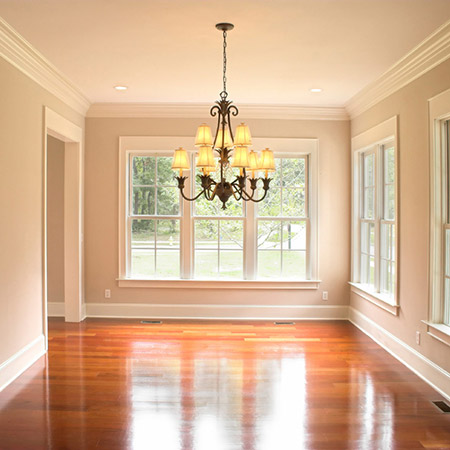
Photo: John Wollwerth/iStock
The first piece of advice Molly Graves, co-founder of the professional organizing company NEAT Method, suggests sounds like a no-brainer: Look at what each wire powers. "The biggest mistake people make is to not first take inventory of which cords are used for what," she says. "You may be surprised at how many cords are plugged in—for long-gone phones, cameras and TVs." Melissa Levy, the professional organizer behind the company declutter+design, suggests also considering whether you rent or own your place, and how long you plan to live there. One of her go-to solutions for homeowner clients—many of whom have young children—is to lay crown molding over wires, especially those for cable or Ethernet. The molding is installed where the wall meets the ceiling, and along room-entrance frames, to hide the cables.
2. A New Way to Look at Rain Gutters
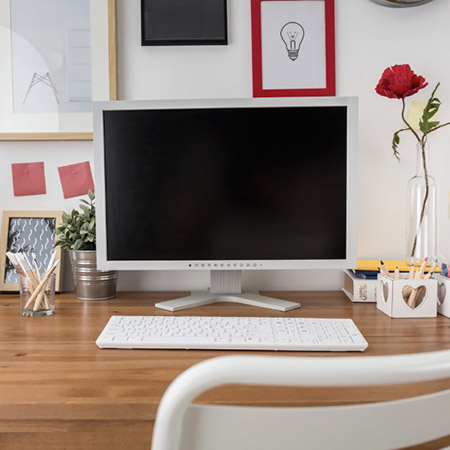
Photo: KatarzynaBialasiewicz/iStock
Levy also recommends strategically placing power strips—by attaching them to the underside, or back, of desks and to walls. It's one of the simplest and most budget-friendly ways to eliminate under-the-desk clutter, she says. This DIY rain-gutter solution featured on Lifehacker uses the same concept. The gutter holds power strips, and even small devices, such as modems and routers, to eliminate desk clutter. To try it: Cut a vinyl rain gutter to fit the length of your desk, then suspend it from the bottom of your desk using hooks.
3. The Addition that Nails Form and Function
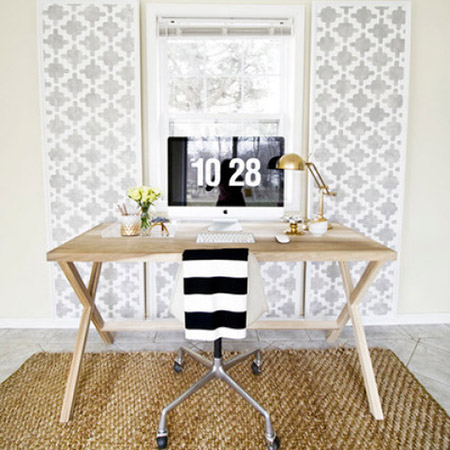
Photo: Sarah Dorsey
Installing a DIY wall panel is an easy way to conceal wires and add personality to your space. This step-by-step tutorial from Houzz contributor and designer Sarah Dorsey shows you how to create your own. Dorsey uses the panels to cover up computer wires behind her desk, but the panels also cover up wires for TVs and other electronics near walls. You can customize the size and look of the panels, which are attached to the wall using Velcro, eliminating any need to drill holes in the wall (a nice solution for renters).
4. The Trick for Disguising Wires In Plain Sight
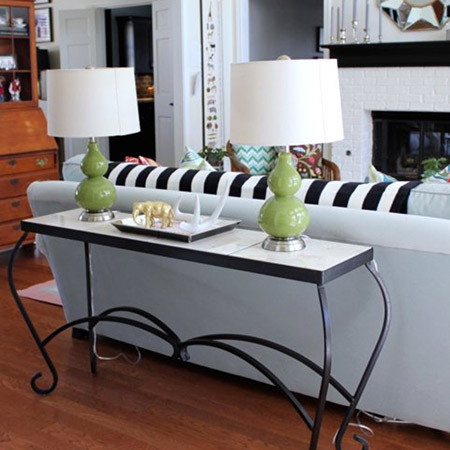
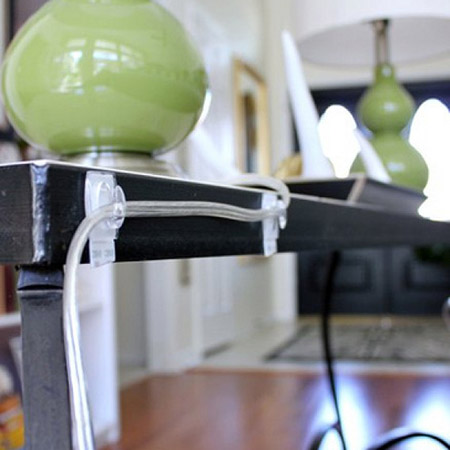
Photos: Hi Sugarplum
If your device sits on top of a table or a desk, consider this simple hack from Cassie Freeman, at the blog Hi Sugarplum. To conceal lamp wires in her living room, she affixes clear hooks with sticky backs behind, and along the legs of, tables, then threads the wires through the hooks. The same can be done with wires from a land-line phone on a hallway table, or those from a computer monitor on a desk. Freeman recommends reversing the direction of each subsequent hook to hold the cord in place more securely.
5. The DIY Mantel that Holds a Secret
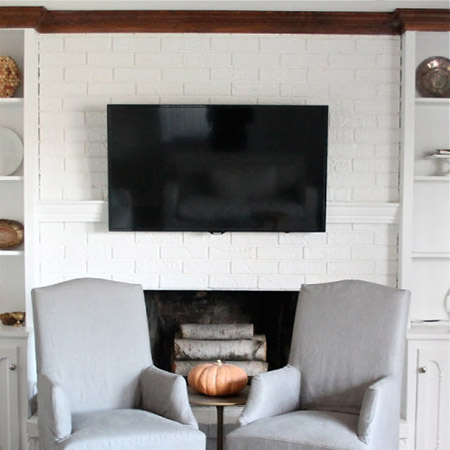
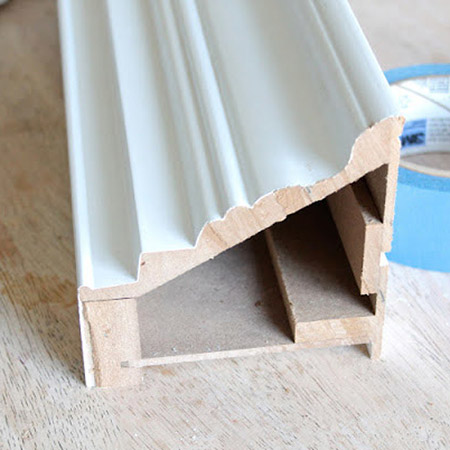
Photos: julieblanner.com
The living room entertainment center is almost always plagued by wires. Blogger Julie Blanner made the cords from her flat-screen TV disappear by hiding them inside a hollow floating shelf. Measure and cut the shelf to fit under the TV, and drill holes into the top of the shelf. The cords can be fed into the holes, through the shelf and into an adjoining bookcase or cabinet that holds an outlet.
6. The Cover that Pulls It All Together
Cord covers can minimize the appearance of wires, and the cable zipper is a particular favorite of Graves'. Cable zippers clip multiple wires into a neat, plastic coil with one single movement (watch NEAT Method demonstrate in the video above), protecting pets from cords, and making cleaning around them easier. Cable zippers are available in varying widths, depending on the number of wires you want to bundle, and can also be cut into shorter lengths and used in multiple places.

Photo: John Wollwerth/iStock
The first piece of advice Molly Graves, co-founder of the professional organizing company NEAT Method, suggests sounds like a no-brainer: Look at what each wire powers. "The biggest mistake people make is to not first take inventory of which cords are used for what," she says. "You may be surprised at how many cords are plugged in—for long-gone phones, cameras and TVs." Melissa Levy, the professional organizer behind the company declutter+design, suggests also considering whether you rent or own your place, and how long you plan to live there. One of her go-to solutions for homeowner clients—many of whom have young children—is to lay crown molding over wires, especially those for cable or Ethernet. The molding is installed where the wall meets the ceiling, and along room-entrance frames, to hide the cables.
2. A New Way to Look at Rain Gutters

Photo: KatarzynaBialasiewicz/iStock
Levy also recommends strategically placing power strips—by attaching them to the underside, or back, of desks and to walls. It's one of the simplest and most budget-friendly ways to eliminate under-the-desk clutter, she says. This DIY rain-gutter solution featured on Lifehacker uses the same concept. The gutter holds power strips, and even small devices, such as modems and routers, to eliminate desk clutter. To try it: Cut a vinyl rain gutter to fit the length of your desk, then suspend it from the bottom of your desk using hooks.
3. The Addition that Nails Form and Function

Photo: Sarah Dorsey
Installing a DIY wall panel is an easy way to conceal wires and add personality to your space. This step-by-step tutorial from Houzz contributor and designer Sarah Dorsey shows you how to create your own. Dorsey uses the panels to cover up computer wires behind her desk, but the panels also cover up wires for TVs and other electronics near walls. You can customize the size and look of the panels, which are attached to the wall using Velcro, eliminating any need to drill holes in the wall (a nice solution for renters).
4. The Trick for Disguising Wires In Plain Sight


Photos: Hi Sugarplum
If your device sits on top of a table or a desk, consider this simple hack from Cassie Freeman, at the blog Hi Sugarplum. To conceal lamp wires in her living room, she affixes clear hooks with sticky backs behind, and along the legs of, tables, then threads the wires through the hooks. The same can be done with wires from a land-line phone on a hallway table, or those from a computer monitor on a desk. Freeman recommends reversing the direction of each subsequent hook to hold the cord in place more securely.
5. The DIY Mantel that Holds a Secret


Photos: julieblanner.com
The living room entertainment center is almost always plagued by wires. Blogger Julie Blanner made the cords from her flat-screen TV disappear by hiding them inside a hollow floating shelf. Measure and cut the shelf to fit under the TV, and drill holes into the top of the shelf. The cords can be fed into the holes, through the shelf and into an adjoining bookcase or cabinet that holds an outlet.
6. The Cover that Pulls It All Together
Cord covers can minimize the appearance of wires, and the cable zipper is a particular favorite of Graves'. Cable zippers clip multiple wires into a neat, plastic coil with one single movement (watch NEAT Method demonstrate in the video above), protecting pets from cords, and making cleaning around them easier. Cable zippers are available in varying widths, depending on the number of wires you want to bundle, and can also be cut into shorter lengths and used in multiple places.



